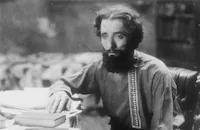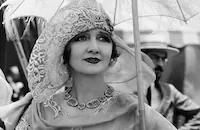Don Juan

Brief Synopsis
Cast & Crew
Alan Crosland
John Barrymore
Mary Astor
Willard Louis
Estelle Taylor
Helene Costello
Film Details
Technical Specs

Synopsis
In the prolog, Don José, warned of his wife's infidelity, seals his wife's lover alive in his hiding place and drives her from the castle; abandoned to his lust, he is stabbed by his last mistress, and with his dying words he implores his son, Juan, to take all from women but yield nothing. Ten years later, young Don Juan is famous as a lover and pursued by many women, including the powerful Lucretia Borgia, who invites him to her ball; his contempt for her incites her hatred of Adriana, the daughter of the Duke Della Varnese, with whom he is enraptured; and Lucretia plots to marry her to Donati and poison the duke. Don Juan intervenes and thwarts the scheme, winning the love of Adriana, but the Borgia declare war on the duke's kinsmen, offering them safety if Adriana marries Donati; Don Juan is summoned to the wedding, but he prefers death to marriage with Lucretia. He escapes and kills Donati in a duel; the lovers are led to the death-tower, but while Adriana pretends suicide, he escapes; and following a series of battles, he defeats his pursuers and is united with Adriana.

Director

Alan Crosland
Cast

John Barrymore

Mary Astor
Willard Louis
Estelle Taylor

Helene Costello

Myrna Loy
Jane Winton
John Roche

June Marlowe
Yvonne Day
Philippe De Lacey

John George
Helena D'algy

Warner Oland

Montagu Love

Josef Swickard
Lionel Braham

Phyllis Haver

Nigel De Brulier

Hedda Hopper
Helen Lee Worthing
Emily Fitzroy
Gustav Von Seyffertitz
Sheldon Lewis
Gibson Gowland
Dick Sutherland
Crew
Walter Anthony
William Axt
William Axt
Maj. Edward Bowes
Ben Carré
Maude Fulton
George R. Groves
Byron Haskins
Gordon Hollingshead
Frank Kesson
Harold Mccord
David Mendoza
Bess Meredyth
Marion Morgan
F. N. Murphy
Victor Vance
A. C. Wilson

Photo Collections
Videos
Movie Clip




Film Details
Technical Specs

Articles
Don Juan (1926)
Intrigued by Don Juan's reputation, a member of the infamous, villainous Spanish Borgia dynasty, Lucretia (Estelle Taylor) invites the handsome rogue to a party. It is at that fateful ball that Don Juan meets the woman who will forever alter his romantic ways, Adriana Della Varnese (Mary Astor), a woman whose innocence and piousness change his perception of female duplicity and malevolence. But Adriana's father Duke Della Varnese is an enemy of the Borgias. Jealous of Don Juan's obvious affection for Adriana, Lucretia hatches a plan to have Adriana marry the repugnant Count Donati (Montagu Love) in exchange for sparing Duke Della Varnese's life.
Don Juan (1926) features a host of Hollywood talent, both established and emerging including Astor, who would one day become one of film noir's most famous femme fatales for her role in The Maltese Falcon (1941). Myrna Loy also appears as Lucretia's plotting, beautiful lady-in-waiting. The part of Lucretia's maid, Maria, was Loy's 11th film role in some 80 film appearances before she made her most famous mark in 1934 as the sophisticated detective Nora Charles in the popular Thin Man series.
Don Juan was the first Vitaphone feature film in which music and sound effects were integrated into the film action. The experiment heralded the end of silent film and proved so wildly successful it led to the second Vitaphone film at Warner Brothers, The Jazz Singer (1927), also directed by Crosland, which has often been considered the first talkie.
Don Juan's New York City premiere was also meant to introduce the new Vitaphone technology -- sound on discs synchronized to run with the picture -- and was accompanied by a welcoming speech from Will H. Hays, the notorious censor behind the Production Code, as well as a host of other demonstrations of Vitaphone's aural virtuosity, including performances of the New York Philharmonic and violinist Jascha Heifitz.
The charismatic Barrymore did all of his own stunts in this lavish, captivating swashbuckler, including the climactic duel between Don Juan and Donati over Adriana's hand. But the thrills of Don Juan were not strictly swashbuckling ones. Don Juan also excels as a love story, and a Warner Brothers press agent helpfully noted that there were a total of 191 kisses exchanged between Barrymore and his many female companions in the film. Barrymore, however, was reportedly unhappy with playing this romantic role, tired of "pansy parts" as he called them, and anxious for meatier roles of the Dr. Jekyll and Mr. Hyde (1920) variety. The set was filled with the stress of Barrymore's increasingly uneven temperament and the stress generated by the presence of Barrymore's romantic lead in Don Juan, Mary Astor, had once been his real life romantic companion as well. Barrymore was 42 and Astor 17, when the pair starred together in Beau Brummel (1924) and enjoyed a secret romance. Astor was enthralled by what she called Barrymore's "magic and magnetism," though she was unable to break away from her controlling parents to marry him. By the time Don Juan began production, however, the couple were no longer together, with Barrymore now engaged to Dolores Costello who would go on to appear with Barrymore in The Sea Beast (1926) and marry the actor in 1928. So, tension on the set ran high, with Barrymore ignoring the heartbroken Astor, or openly taunting her by flirting with other actresses on the set when he wasn't huddling with Costello.
Don Juan's production design was a meticulous undertaking involving extensive research to create the film's extraordinary vision captured in Ben Carre's sets. From the film's prologue, where the gorgeously attired young Don Juan and his father Don Jose (played by Barrymore in aging make-up) survey an opulent room filled with women, Don Juan has a rich, and often decadent atmosphere befitting its mix of comedy and extremes in violence and eroticism.
Director: Alan Crosland
Producer: Jack Warner
Screenplay: Bess Meredyth; based on the poem of the same name by Lord George Gordon Byron
Cinematography: Byron Haskins
Production Design: Ben Carre
Music: William Axt
Cast: John Barrymore (Don Juan), Mary Astor (Adriana Della Varnese), Willard Louis (Pedrillo), Estelle Taylor (Lucretia Borgia), Helene Costello (Rena), Count Donati (Montagu Love), Warner Oland (Caesar Borgia), Myrna Loy (Maria, Lady in Waiting), Josef Swickard (Duke Della Varnese).
BW-113m.
by Felicia Feaster

Don Juan (1926)
Quotes
Trivia
Don Juan plants 191 kisses on various females during the course of the film, an average of one every 53 seconds.
The first movie to have a pre-recorded soundtrack. The orchestra was off to the side of the set being recorded while the scenes were shot.













